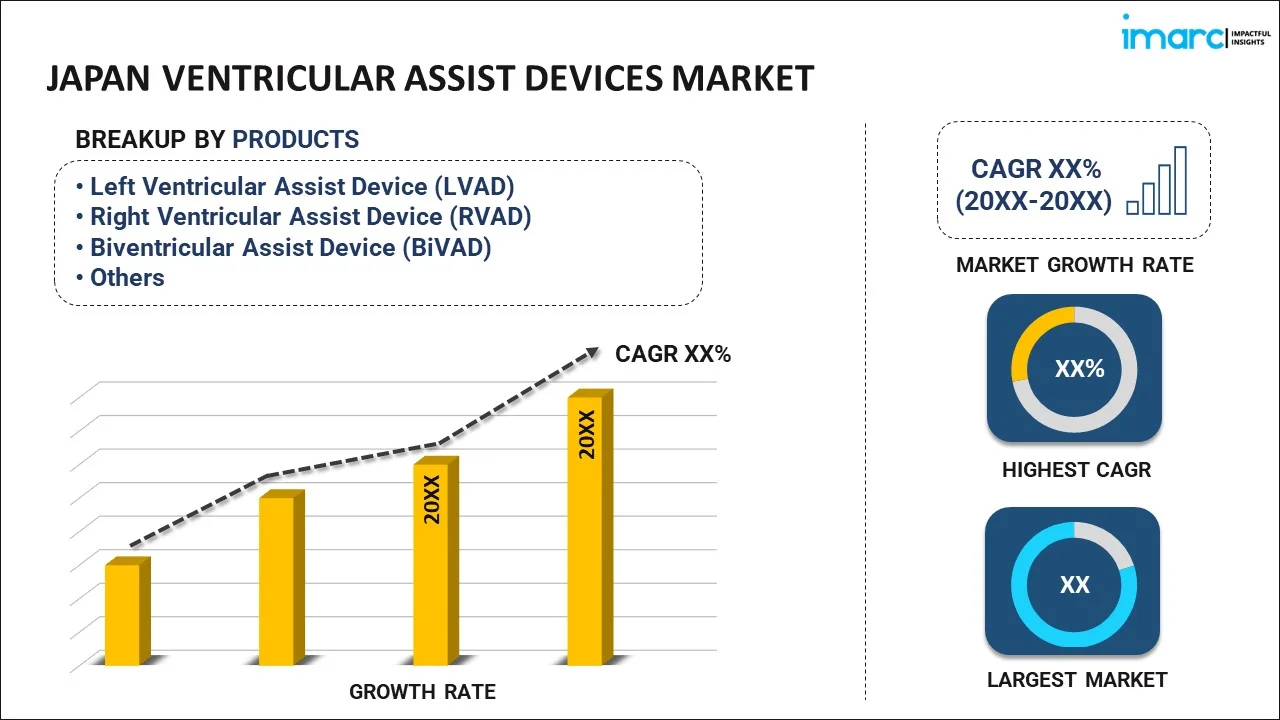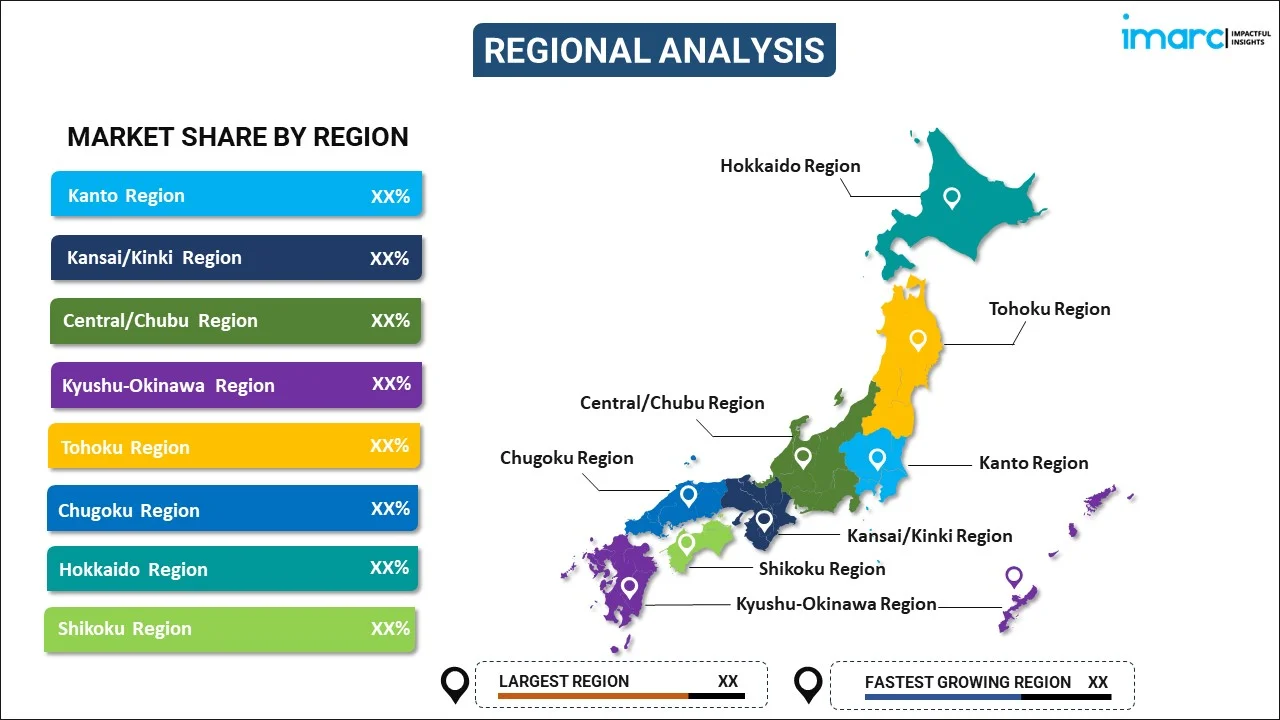
Japan Ventricular Assist Devices Market Report by Product (Left Ventricular Assist Device (LVAD), Right Ventricular Assist Device (RVAD), Biventricular Assist Device (BiVAD), and Others), Flow Type (Pulsatile Flow, Non-Pulsatile or Continuous Flow), Design (Implantable Ventricular Assist Devices, Non-Implantable Ventricular Assist Devices), Application (Bridge-to-Transplant (BTT) Therapy, Destination Therapy, Bridge to Recovery and Bridge to Candidacy), End User (Ambulatory Surgery Centers, Hospital, and Others), and Region 2025-2033
Market Overview:
Japan ventricular assist devices market size is projected to exhibit a growth rate (CAGR) of 9.1% during 2025-2033. The increasing incidence of heart failure and other cardiovascular disorders, along with the rising demand for ventricular assist devices to treat such conditions, is driving the market.
|
Report Attribute
|
Key Statistics
|
|---|---|
|
Base Year
|
2024 |
|
Forecast Years
|
2025-2033
|
|
Historical Years
|
2019-2024
|
| Market Growth Rate (2025-2033) | 9.1% |
Ventricular assist devices (VADs) are mechanical pumps used to support the function of a weakened or failing heart. These devices are implanted surgically and assist the heart in pumping blood throughout the body, helping to maintain adequate circulation and oxygenation. VADs are typically employed as a bridge to transplant for patients awaiting a heart transplant, as a temporary solution for those recovering from heart surgery or suffering from acute heart failure, or as destination therapy for individuals who are not eligible for transplantation. There are various types of VADs, including left ventricular assist devices (LVADs) and right ventricular assist devices (RVADs), which can be used individually or in combination to support different parts of the heart. VADs can significantly improve a patient's quality of life and survival while awaiting transplantation or as a long-term solution for those not eligible for a heart transplant. However, they require careful monitoring and management by a specialized medical team due to potential complications and the need for regular maintenance.
Japan Ventricular Assist Devices Market Trends:
The ventricular assist devices market in Japan has witnessed remarkable growth in recent years due to several key drivers. Firstly, advancements in medical technology have paved the way for the development of more sophisticated and reliable VADs. These innovations, such as miniaturization and improved durability, have expanded the patient pool eligible for VAD therapy. Furthermore, an aging regional population has contributed significantly to the market's expansion. As the elderly population continues to grow, so does the prevalence of heart failure, creating a higher demand for VADs as a bridge to transplant or destination therapy. Additionally, the rising incidence of cardiovascular diseases, often driven by lifestyle factors such as sedentary living and poor dietary habits, has boosted the need for VADs as a life-saving intervention. The increased awareness of heart health and improved access to healthcare services in many regions have also positively influenced the VAD market. Moreover, strategic collaborations between medical device manufacturers and healthcare providers, which have led to increased product availability and patient access, are expected to drive the ventricular assist devices market in Japan during the forecast period.
Japan Ventricular Assist Devices Market Segmentation:
IMARC Group provides an analysis of the key trends in each segment of the market, along with forecasts at the country level for 2025-2033. Our report has categorized the market based on product, flow type, design, application, and end user.
Product Insights:

- Left Ventricular Assist Device (LVAD)
- Right Ventricular Assist Device (RVAD)
- Biventricular Assist Device (BiVAD)
- Others
The report has provided a detailed breakup and analysis of the market based on the product. This includes left ventricular assist device (LVAD), right ventricular assist device (RVAD), biventricular assist device (BiVAD), and others.
Flow Type Insights:
- Pulsatile Flow
- Non-Pulsatile or Continuous Flow
A detailed breakup and analysis of the market based on the flow type have also been provided in the report. This includes pulsatile flow and non-pulsatile or continuous flow.
Design Insights:
- Implantable Ventricular Assist Devices
- Non-Implantable Ventricular Assist Devices
The report has provided a detailed breakup and analysis of the market based on the design. This includes implantable ventricular assist devices and non-implantable ventricular assist devices.
Application Insights:
- Bridge-to-Transplant (BTT) Therapy
- Destination Therapy
- Bridge to Recovery and Bridge to Candidacy
A detailed breakup and analysis of the market based on the application have also been provided in the report. This includes bridge-to-transplant (BTT) therapy, destination therapy, and bridge to recovery and bridge to candidacy.
End User Insights:
- Ambulatory Surgery Centers
- Hospital
- Others
The report has provided a detailed breakup and analysis of the market based on end user. This includes ambulatory surgery centers, hospital, and others.
Regional Insights:

- Kanto Region
- Kansai/Kinki Region
- Central/ Chubu Region
- Kyushu-Okinawa Region
- Tohoku Region
- Chugoku Region
- Hokkaido Region
- Shikoku Region
The report has also provided a comprehensive analysis of all the major regional markets, which include Kanto Region, Kansai/Kinki Region, Central/ Chubu Region, Kyushu-Okinawa Region, Tohoku Region, Chugoku Region, Hokkaido Region, and Shikoku Region.
Competitive Landscape:
The market research report has also provided a comprehensive analysis of the competitive landscape. Competitive analysis such as market structure, key player positioning, top winning strategies, competitive dashboard, and company evaluation quadrant has been covered in the report. Also, detailed profiles of all major companies have been provided.
Japan Ventricular Assist Devices Market Report Coverage:
| Report Features | Details |
|---|---|
| Base Year of the Analysis | 2024 |
| Historical Period | 2019-2024 |
| Forecast Period | 2025-2033 |
| Units | Million USD |
| Scope of the Report | Exploration of Historical and Forecast Trends, Industry Catalysts and Challenges, Segment-Wise Historical and Predictive Market Assessment:
|
| Products Covered | Left Ventricular Assist Device (LVAD), Right Ventricular Assist Device (RVAD), Biventricular Assist Device (BiVAD), Others |
| Flow Types Covered | Pulsatile Flow, Non-Pulsatile or Continuous Flow |
| Designs Covered | Implantable Ventricular Assist Devices, Non-Implantable Ventricular Assist Devices |
| Applications Covered | Bridge-to-Transplant (BTT) Therapy, Destination Therapy, Bridge to Recovery and Bridge to Candidacy |
| End Users Covered | Ambulatory Surgery Centers, Hospital, Others |
| Regions Covered | Kanto Region, Kansai/Kinki Region, Central/ Chubu Region, Kyushu-Okinawa Region, Tohoku Region, Chugoku Region, Hokkaido Region, Shikoku Region |
| Customization Scope | 10% Free Customization |
| Post-Sale Analyst Support | 10-12 Weeks |
| Delivery Format | PDF and Excel through Email (We can also provide the editable version of the report in PPT/Word format on special request) |
Key Questions Answered in This Report:
- How has the Japan ventricular assist devices market performed so far and how will it perform in the coming years?
- What has been the impact of COVID-19 on the Japan ventricular assist devices market?
- What is the breakup of the Japan ventricular assist devices market on the basis of product?
- What is the breakup of the Japan ventricular assist devices market on the basis of flow type?
- What is the breakup of the Japan ventricular assist devices market on the basis of design?
- What is the breakup of the Japan ventricular assist devices market on the basis of application?
- What is the breakup of the Japan ventricular assist devices market on the basis of end user?
- What are the various stages in the value chain of the Japan ventricular assist devices market?
- What are the key driving factors and challenges in the Japan ventricular assist devices?
- What is the structure of the Japan ventricular assist devices market and who are the key players?
- What is the degree of competition in the Japan ventricular assist devices market?
Key Benefits for Stakeholders:
- IMARC’s industry report offers a comprehensive quantitative analysis of various market segments, historical and current market trends, market forecasts, and dynamics of the Japan ventricular assist devices market from 2019-2033.
- The research report provides the latest information on the market drivers, challenges, and opportunities in the Japan ventricular assist devices market.
- Porter's five forces analysis assist stakeholders in assessing the impact of new entrants, competitive rivalry, supplier power, buyer power, and the threat of substitution. It helps stakeholders to analyze the level of competition within the Japan ventricular assist devices industry and its attractiveness.
- Competitive landscape allows stakeholders to understand their competitive environment and provides an insight into the current positions of key players in the market.
Need more help?
- Speak to our experienced analysts for insights on the current market scenarios.
- Include additional segments and countries to customize the report as per your requirement.
- Gain an unparalleled competitive advantage in your domain by understanding how to utilize the report and positively impacting your operations and revenue.
- For further assistance, please connect with our analysts.
 Inquire Before Buying
Inquire Before Buying
 Speak to an Analyst
Speak to an Analyst
 Request Brochure
Request Brochure
 Request Customization
Request Customization




.webp)




.webp)












